Jesse James and his James-Younger Gang robbed Republican businesses following the Civil War — and became a national celebrity in the process.
While Jesse James is often the first man to come to mind when reducing the idea of the Old West to an individual, his image of being a hero is just a myth. Perhaps it is fitting that the idea of Jesse James as a gunslinging frontier vigilante should represent the imaginary idea of the American Frontier as depicted in Hollywood.

Public DomainThe last portrait taken of outlaw Jesse James while he was alive, certified by his wife.
An ex-Confederate guerilla whose exploits set the pace for the wild decades to come, Jesse James was a romantic figure in the years after his early death as he was likened to a kind of American Robin Hood.
But the real Jesse James was anything but a hero.
Becoming Jesse James
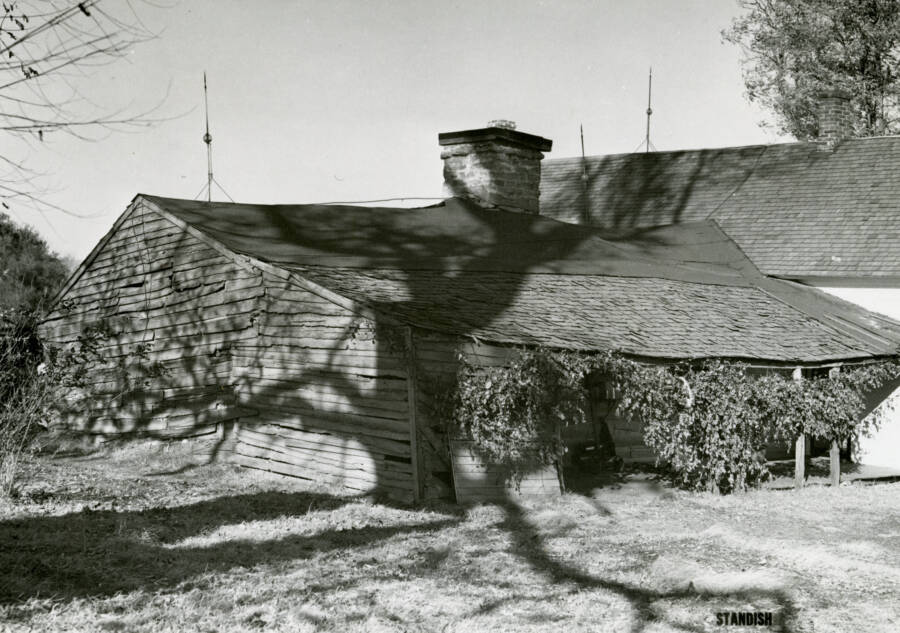
Public DomainThe James’ family home in Clay County, Missouri.
Jesse Woodson James was born in Missouri on September 5, 1847. This was around the same time and place where author Mark Twain would later set his picturesque novels about Tom Sawyer and Huckleberry Finn, though there wasn’t a lot of whitewashing and river rafting going on in the James family.
Jesse James’ natural father, Robert, was a slave-owning Baptist preacher from Kentucky who was always looking for the next big score that would make him rich.
When his hemp farm didn’t pan out in Kentucky, Robert James moved to Missouri to try his hand at cotton. When his six slaves and 100 acres failed to make him a millionaire there, he packed light and moved to California to get in on the Gold Rush.
The elder James then died in California in 1850, never having made the fortunes he was hoping for, and his widow took three-year-old Jesse James and his older brother Frank James back to the family farm where she remarried within a couple of years.
The James farm led a quiet life for the next decade or so, though that quietude did not mean peace.

Wikimedia CommonsJesse and Frank James in 1872.
1850s Missouri was right next to the opening act of America’s Civil War — and the James family was in the thick of it.
The trouble started with the 1854 Kansas-Nebraska Act. The Act permitted territories to each vote on whether they would be admitted into the Union as a free or a slave state. Nobody even tried to make Nebraska a slave state, but Kansas was right on the cusp of going either way. If slavery was abolished in Kansas, Missouri’s slaveholders feared that their enslaved laborers would escape there.
Jesse James thus grew up in one of the most pro-slavery counties in the state, and as slave owners themselves, the James family’s sympathy laid entirely with pro-slavery raiders. These raiders wound up staging wildly fraudulent elections to make Kansas a slave territory. The fighting between pro and anti-slavery forces lasted 12 years in a period known as Bleeding Kansas, until the end of the war.
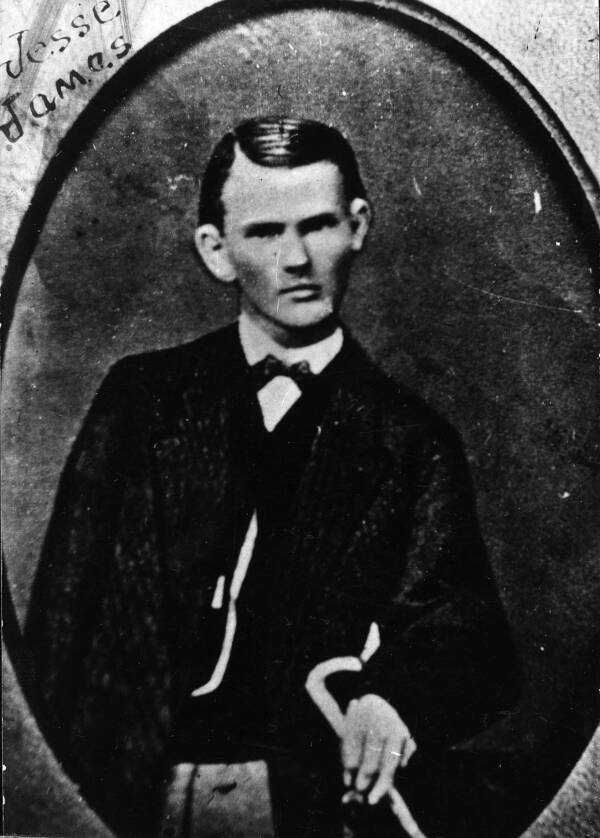
Public DomainA portrait of Jesse James wearing a suit. Circa 1864.
As the Civil War raged out West, bands of raiders and outlaws struck deep into each other’s territory to slaughter civilians without mercy. Hangings, lynchings, and scalpings were routine on both sides.
Jesse James’ stepfather Reuben, for example, was seized by Union troops in 1863 and tortured for information about his team of guerilla Confederate fighters called “bushwhackers.”
The troops hoisted him by the neck with a noose tossed over a branch until he passed out, and also allegedly tied up the 16-year-old Jesse James and gave him a lashing despite the fact that he hadn’t been involved in any of the raids up to that point.
A Guerilla Confederate
Previously too young to join in the rebellions, perhaps this personal act of violence against James was the impetus for his joining up with the Confederate guerilla militia.
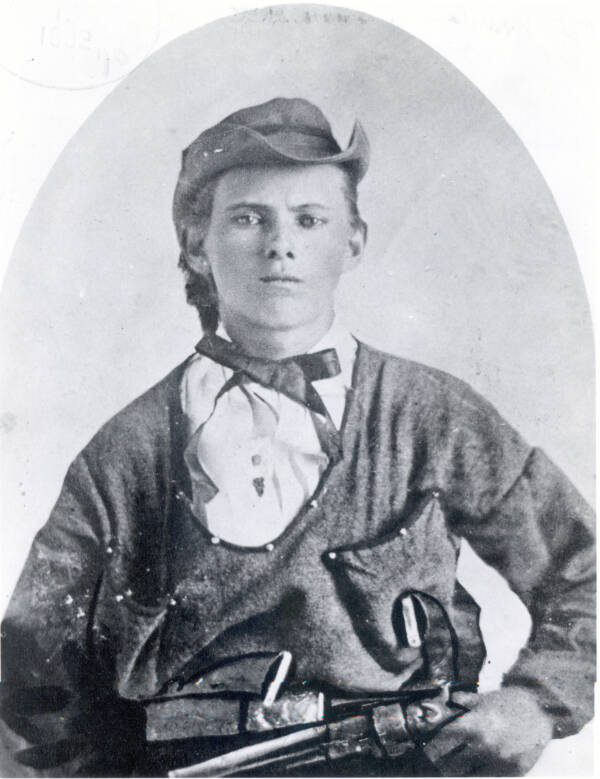
Public DomainA portrait of a young Jesse James. Circa 1864.
In the same year that the raid took place on the James farm, Frank James joined up with a guerilla organization that rode into Lawrence, Kansas, and slaughtered around 200 civilians.
Jesse James joined up with these outlaws, too, in 1864 at just 16 under the leadership of “Bloody Bill” Anderson. Bloody Bill led the James boys and his unit in the now-infamous raid on Centralia where they killed several unarmed civilians and collected their scalps.
The group then attacked a train of wounded and deactivated Union soldiers, killing at least 100 men. Jesse and Frank James rode down the fleeing survivors and shot every man who tried to surrender including the Army major in command.

Public DomainJesse James (right) poses with brother Frank James (seated) and Charles Fletcher Taylor (left); Frank is wearing a “Civil War studio costume.”
The end of the war saw Missouri occupied and under martial law. The Emancipation Proclamation hadn’t affected the state, which had remained officially neutral during the war, but in 1866 the 13th and 14th Amendments abolished slavery in every territory.
With that, much of the wealth in the James family vanished and the sons turned to a life of crime. Jesse James had been shot in the chest during the War and was nursed back to health by his first cousin who he later married.
When he recovered, Jesse James took part in a jailbreak that freed several members of his guerilla gang under leader Archie Clement. But when Clement was later killed, Jesse James took over the gang and led several daring bank robberies including one in Richmond, Missouri, in which the town’s mayor was killed.
Together the James brothers committed countless small-scale robberies over the next few years, though their gang gradually lost members to death in action, arrests, and lynchings.
Lost in the din of underground resistance activity, the outlaws of the James Gang went largely unnoticed until December 1869, when Jesse James outright murdered a bank cashier he mistook for the Union officer who had killed his old boss, Bloody Bill.
A huge manhunt was organized to catch the killers, but Frank and Jesse James’ ability to evade capture quickly bore their legend.
The James-Younger Gang
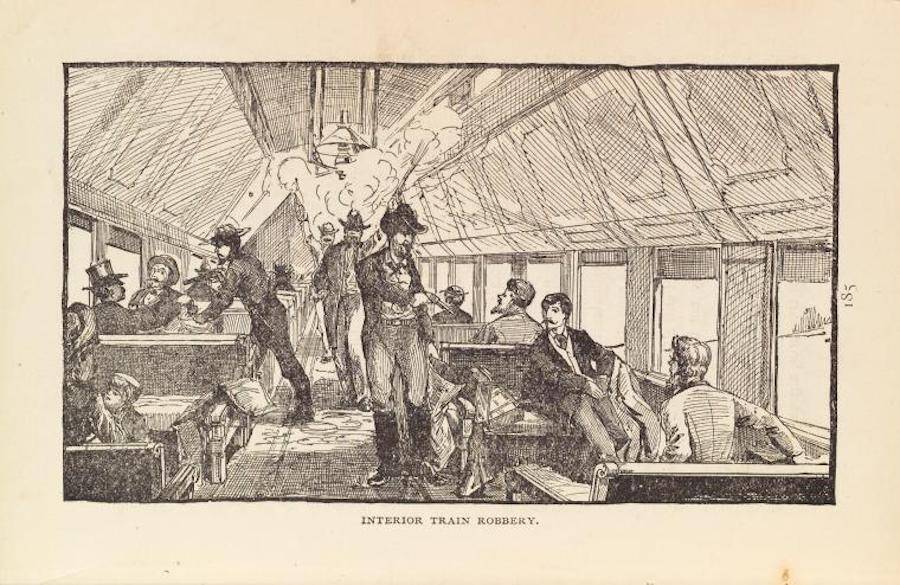
Digital Public LibraryAn illustration by Donald Jay, dated 1882, depicting a train robbery by Jesse James and his gang.
Probably the biggest factor in James’ rise to fame was the symbiotic relationship he fell into with the publishers of the Kansas City Star, a firmly pro-Confederate paper that constantly editorialized anti-Reconstruction policies.
The paper’s editor sensed an opportunity in Jesse James. He envisioned the outlaw as a symbol of the resistance and consequently gave James endless print space to publicize his rebellions against the Republicans.
Jesse James wrote himself as the titular leader of an eight-man posse called the James-Younger Gang, which consisted of Cole Younger and his brothers John, Jim, and Bob, and other former Confederates.
James and his men spent several years robbing banks all over the region, retrofitting their criminal exploits to garner as much attention as possible while portraying themselves as heroes of the Confederacy — Robin Hoods, of sorts — catering to the lost voices of disenfranchised Confederates.
“We are not thieves,” Jesse James reportedly wrote, “we are bold robbers. I am proud of the name, for Alexander the Great was a bold robber, and Julius Caesar, and Napoleon Bonaparte.”

Wikimedia CommonsThe wanted poster for Jesse James.
By 1873, the Reconstruction Republican governor of Missouri had called for all the help he could get against Confederate guerrillas, but under the law of the time, he couldn’t offer a reward from his own office.
The outlaws thus frequently raided stagecoaches, public events, and trains, once in 1873 while wearing KKK hoods as a message to the federal authorities, with basically no consequence.
Robbing trains turned out to be a risky decision as the other great force of the West – the Railroad Barons – had a private army of their own to take down the James-Younger gang.
That private army was none other than the Pinkerton Detective Agency, which by that time had tons of experience with cracking skulls at labor strikes and tracking down counterfeiters for the federal government. When they got the commission to capture Jesse James, the Pinkertons moved a little too fast and got caught in an ambush, where a deputy sheriff and several of the agency’s men were shot.
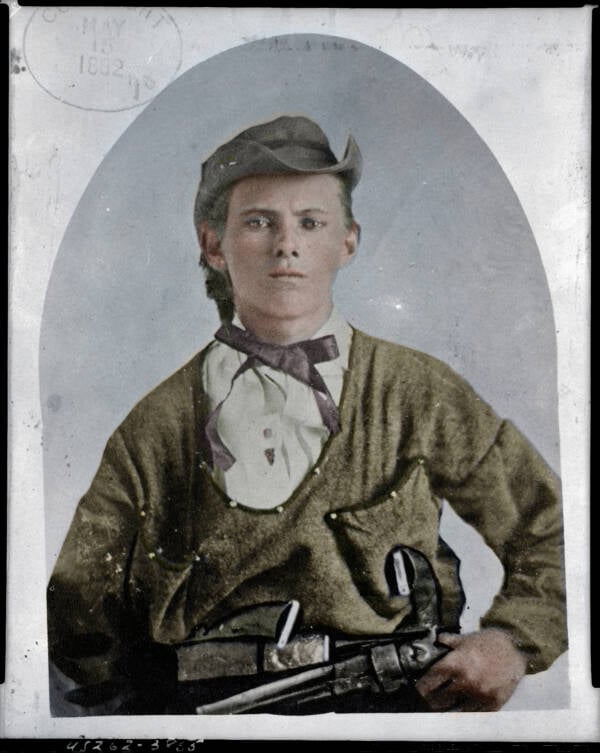
Wikimedia Commons; colorized by Matt LoughreyA colorized portrait of a young Jesse James.
After that, Allan Pinkerton himself led the manhunt, the climax of which was a raid at the James farm that intentionally turned into a sneak arson attack when the Pinkertons threw a firebomb through the window.
That bomb killed Jesse James’ younger half-brother who was sleeping at the time and injured his mother. Pinkerton later denied burning the house down on purpose, though research a century later turned up a letter in which Pinkerton bragged about what he planned to do.
After the malicious wounding of a woman and the death of a boy, the Pinkertons withdrew, having been utterly defeated by the James brothers.
The Northfield Bank Fiasco And The Downfall Of The James-Younger Gang
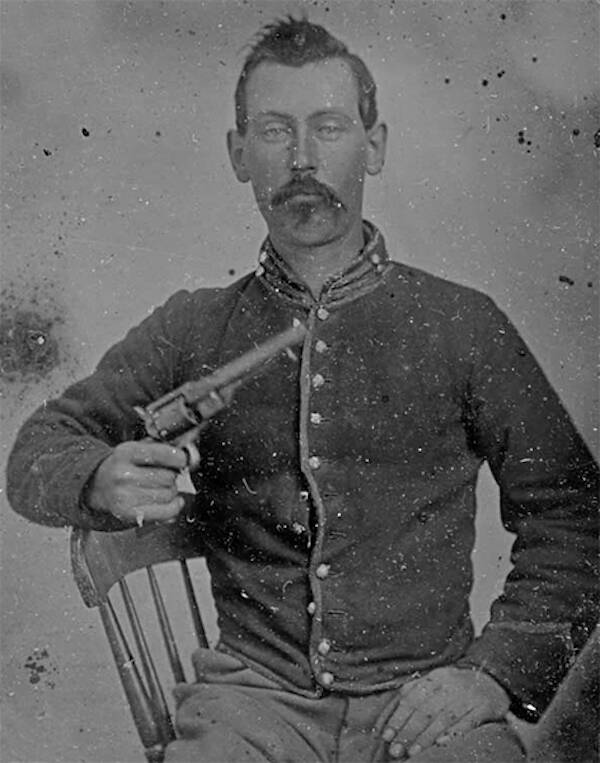
Wikimedia CommonsA photograph of Dick Liddill, one of the last surviving members of the James-Younger gang.
Jesse James went on a killing spree after the attack on his house.
Several local collaborators suspected of having worked with the Pinkertons turned up dead in their homes. The James-Younger gang became more selective about their targets, favoring banks and other properties owned by Republicans. One of these, the Northfield Bank in Minnesota, would mark the turning point in the fortunes of Frank and Jesse James.
The Northfield Bank robbery went down on September 7, 1876. That morning, the James-Younger Gang rode into town and converged on the bank. Two of the outlaws took up sentry positions outside while the rest of the robbers went in to crack the safe. Surprisingly, the clerk had the nerve to lie and tell them that the safe was on a time lock, even though one of the robbers was holding a Bowie knife to his throat.
As the clerk received a beating that left his skull cracked, townspeople grew suspicious of the lookouts and started a confrontation outside the bank.
The sentries shot into the air to clear the street, which soon turned into a gunfight. The men inside the bank dropped what they were doing and, pausing only to shoot the clerk who’d held them up, made a run for it. Local law enforcement was already converging on the scene and the gang fled.
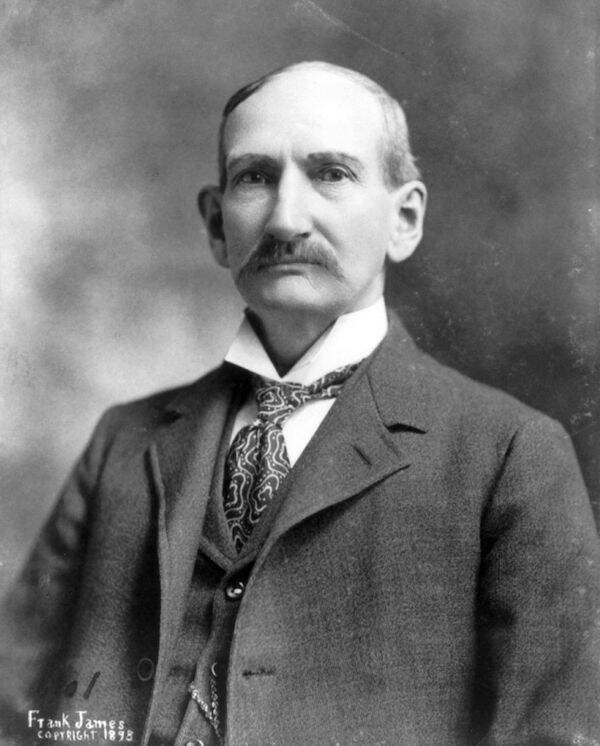
Wikimedia CommonsA portrait of Frank James, Jesse James’ older brother.
Frank and Jesse James recovered from the Northfield disaster but didn’t keep much of a low profile as they continued to rob trains, stores, and the like. Frank James seemed to have reformed. He renounced his outlaw lifestyle and moved to Virginia for what he hoped would be a quiet retirement. Jesse James, however, couldn’t stay away from crime.
He assembled a new mob which proved difficult to keep together, even for a quick-on-the-trigger killer like Jesse James, who may have murdered one of his own men to keep him from giving himself up. By 1882, James was living with the last two members of his gang who hadn’t run off or died, Charley and Robert Ford.
According to their later account, James had made a few inappropriate comments and overtures toward their sister, Martha, not to mention the fact that there was a hefty $5,000 bounty on James’ head dead or alive. At least these are the reasons that the Ford brothers cited after the death of Jesse James.
The Death Of Jesse James
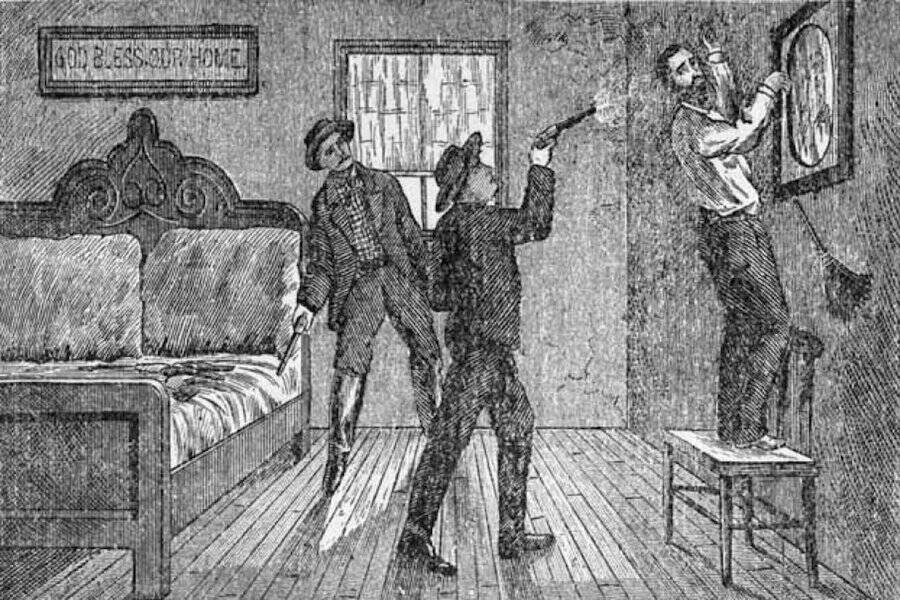
Wikimedia CommonsAn illustration that depicts that grisly death of Jesse James at the hands of his criminal collaborator, Robert Ford.
On April 3, 1882, the morning of a planned robbery, Jesse James got up and ate breakfast. Contrary to his usual habit, he brought his revolvers to the table with him, suggesting he sensed trouble.
James reportedly took a moment to step up onto a chair in the living room and clean a dusty picture on the wall. When he did this, Robert Ford walked right up behind him and fired a single shot into the back of the 35-year-old Jesse James’ head.

Public DomainJesse James’ home in Buchanan County, where he was killed.
To the Ford brothers’ shock, they were actually arrested when they dragged James’ body in to claim the reward. Charged with murder and swiftly convicted, both men were sentenced to death by hanging.
That day, Missouri’s governor issued a pardon for both men and saw to it that they got their reward.
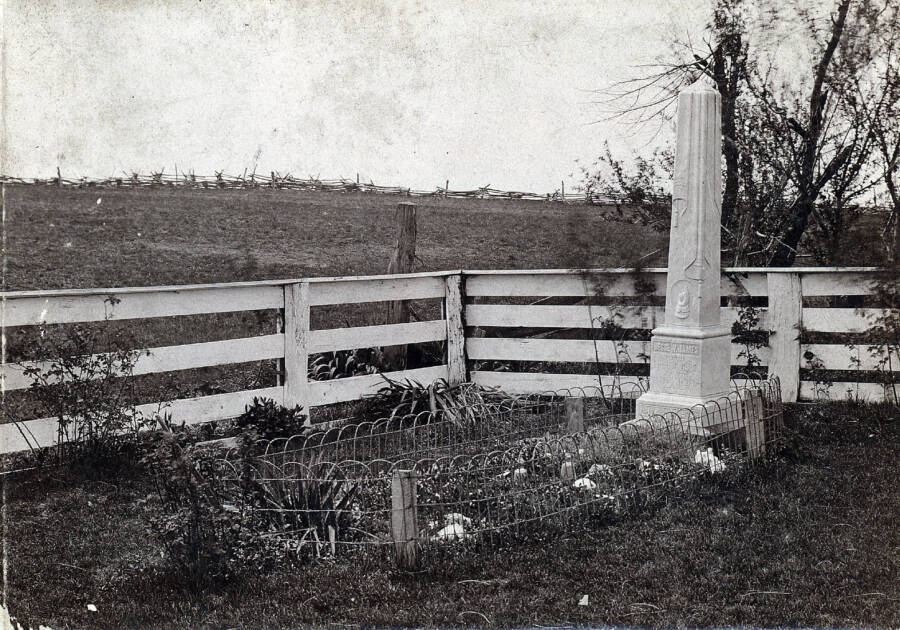
The gravesite of Jesse James in Clay County.
In the decades that followed, stage and screen immortalized the James-Younger gang and Jesse James in particular as larger-than-life Wild West outlaws.
Since the death of Jesse James, he has been portrayed as a frontier hero or a Robin Hood figure who balked against corporations and stood in defense of the poor farmer, but nothing in his history suggests that he did either of these things.
Today, the place where Jesse James died is marked by a stone plinth while the house itself has been moved to St. Joseph’s and painstakingly preserved for thousands of visitors a year.
To learn more about wild westerners like outlaw Jesse James, read about these 10 iconic wild west figures. Then, learn about the forgotten black cowboys of the frontier.





